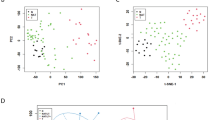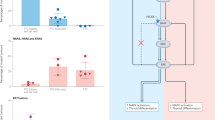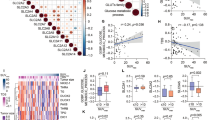Abstract
Cancer reflects the progressive accumulation of genetic alterations and subsequent genetic instability of cells. Cytogenetic studies have demonstrated the importance of aneuploidy in differentiated thyroid cancer development. The pituitary tumour transforming gene (PTTG), also known as securin, is a mitotic checkpoint protein which inhibits sister chromatid separation during mitosis. PTTG is highly expressed in many cancers and overexpression of PTTG induces aneuploidy in vitro. Using fluorescent intersimple sequence repeat PCR (FISSR-PCR), we investigated the relationship between PTTG expression and the degree of genetic instability in normal and tumorous thyroid samples. The genomic instability index (GI index) was 6.7–72.7% higher in cancers than normal thyroid tissues. Follicular thyroid tumours exhibited greater genetic instability than papillary tumours (27.6% (n=9) versus 14.5% (n=10), P=0.03). We also demonstrated a strong relationship between PTTG expression and the degree of genetic instability in thyroid cancers (R2=0.80, P=0.007). To further investigate PTTG's role in genetic instability, we transfected FTC133 thyroid follicular cells and observed increased genetic instability in cells overexpressing PTTG compared with vector-only-transfected controls (n=3, GI Index VO=29.7±5.2 versus PTTG=63.7±6.4, P=0.013). Further, we observed a dose response in genetic instability and PTTG expression (GI Index low dose (0.5 μg DNA/ six-well plate) PTTG=15.3%±1.7 versus high dose (3 μg DNA) PTTG=50.8%±3.3, P=0.006). Overall, we describe the first use of FISSR-PCR in human cancers, and demonstrate that PTTG expression correlates with genetic instability in vivo, and induces genetic instability in vitro. We conclude that PTTG may be an important gene in the mutator phenotype development in thyroid cancer.
This is a preview of subscription content, access via your institution
Access options
Subscribe to this journal
Receive 50 print issues and online access
$259.00 per year
only $5.18 per issue
Buy this article
- Purchase on SpringerLink
- Instant access to full article PDF
Prices may be subject to local taxes which are calculated during checkout




Similar content being viewed by others
References
Barril N, Carvalho-Sales AB and Tajara EH . (2000). Cancer Genet. Cytogenet., 117, 50–56.
Basik M, Stoler DL, Kontzoglou KC, Rodriguez-Bigas MA, Petrelli NJ and Anderson GR . (1997). Genes Chromosomes Cancer, 18, 19–29.
Bernal JA, Luna R, Espina A, Lazaro I, Ramos-Morales F, Romero F, Arias C, Silva A, Tortolero M and Pintor-Toro JA . (2002). Nat. Genet., 32, 306–311.
Boelaert K, McCabe CJ, Tannahill LA, Gittoes NJ, Holder RL, Watkinson JC, Bradwell AR, Sheppard MC and Franklyn JA . (2003a). J. Clin. Endocrinol. Metab., 88, 2341–2347.
Boelaert K, Tannahill LA, Bulmer JN, Kachilele S, Chan SY, Kim D, Gittoes NJ, Franklyn JA, Kilby MD and McCabe CJ . (2003b). FASEB J., 17, 1631–1639.
Chang B, Watanabe K, Broude E, Fang J, Poole J, Kalinichenko T and Roninson I . (2000a). Proc. Natl. Acad. Sci. USA, 97, 4291–4296.
Chang BD, Wantanabe K, Broude EV, Fang J, Poole JC, Kalinichenko TV and Roninson IB . (2000b). Proc. Natl. Acad. Sci. USA, 97, 4291–4296.
Cooper M, Balajee S and Bohr A . (1999). Mol. Biol. Cell, 10, 2119–2129.
Dobosz T, Lukienczuk T, Sasiadek M, Kuczy A, Jankowska E and Blin N . (2000). Oncology, 58, 305–310.
Heaney AP, Singson R, McCabe CJ, Nelson V, Nakashima M and Melmed S . (2000). Lancet, 355, 716–719.
Kumar LD, Kathirvel M, Rao GV and Nagaraju J . (2001). Forensic. Sci. Int., 116, 63–68.
Loeb L . (1991). Cancer Res., 51, 3075–3079.
McCabe CJ, Boelaert K, Tannahill LA, Heaney AP, Stratford AL, Khaira JS, Hussain S, Sheppard MC, Franklyn JA and Gittoes NJ . (2002). J. Clin. Endocrinol. Metab., 87, 4238–4244.
McCabe CJ, Khaira JS, Boelaert K, Heaney AP, Tannahill LA, Hussain S, Mitchell R, Olliff J, Sheppard MC, Franklyn JA and Gittoes NJ . (2003). Clin. Endocrinol. (Oxf), 58, 141–150.
Mu YM, Oba K, Yanase T, Ito T, Ashida K, Goto K, Morinaga H, Ikuyama S, Takayanagi R and Nawata H . (2003). Endocr. J., 50, 771–781.
Nagao K, Adachi Y and Yanagida M . (2004). Nature, 430, 1044–1048.
Nagaraju J, Kathirvel M, Subbaiah EV, Muthulakshmi M and Kumar LD . (2002). Mol. Cell Probes, 16, 67–72.
Pei L and Melmed S . (1997). Mol. Endocrinol., 11, 433–441.
Ramaswamy S, Tamayo P, Rifkin R, Mukherjee S, Yeang CH and Golub TR . (2001). Proc. Natl. Acad. Sci. USA, 98, 15149–15154.
Romero F, Gil-Bernabe AM, Saez C, Japon MA, Pintor-Toro JA and Tortolero M . (2004). Mol. Cell Biol., 24, 2720–2733.
Romero F, Multon MC, Ramos-Morales F, Dominguez A, Bernal JA, Pintor-Toro JA and Tortolero M . (2001). Nucleic Acids Res., 29, 1300–1307.
Saez C, Pereda T, Borrero JJ, Espina A, Romero F, Tortolero M, Pintor-Toro JA, Segura DI and Japon MA . (2002). Oncogene, 21, 8173–8177.
Schlumberger MJ . (1998). N. Engl. J. Med., 338, 297–306.
Solbach C, Roller M, Fellbaum C, Nicoletti M and Kaufmann M . (2004). Breast, 13, 80–81.
Stoler DL, Datta RV, Charles MA, Block AW, Brenner BM, Sieczka EM, Hicks Jr WL, Loree TR and Anderson GR . (2002). Head Neck, 24, 290–295.
Taruscio D, Carcangiu ML, Ried T and Ward DC . (1994). Genes Chromosomes Cancer, 9, 180–185.
Viswanathan M, Sangiliyandi G, Vinod SS, Mohanprasad BK and Shanmugam G . (2003). Clin. Cancer Res., 9, 1057–1062.
Ward LS, Brenta G, Medvedovic M and Fagin JA . (1998). J. Clin. Endocrinol. Metab., 83, 525–530.
Wiseman SM, Loree TR, Rigual NR, Hicks Jr WL, Winston JS, Swede H, Bartos JD, Anderson GR and Stoler DL . (2003). Head Neck, 25, 825–832.
Yu R, Heaney AP, Lu W, Chen J and Melmed S . (2000). J. Biol. Chem., 275, 36502–36505.
Yu R, Lu W, Chen J, McCabe CJ and Melmed S . (2003). Endocrinology, 144, 4991–4998.
Zhang X, Horwitz GA, Heaney AP, Nakashima M, Prezant TR, Bronstein MD. and Melmed S . (1999). J. Clin. Endocrinol. Metab., 84, 761–767.
Zhou Y, Mehta KR, Choi AP, Scolavino S and Zhang X . (2003). J. Biol. Chem., 278, 462–470.
Zietkiewicz E, Rafalski A and Labuda D . (1994). Genomics, 20, 176–183.
Author information
Authors and Affiliations
Corresponding author
Rights and permissions
About this article
Cite this article
Kim, D., Pemberton, H., Stratford, A. et al. Pituitary tumour transforming gene (PTTG) induces genetic instability in thyroid cells. Oncogene 24, 4861–4866 (2005). https://doi.org/10.1038/sj.onc.1208659
Received:
Revised:
Accepted:
Published:
Issue date:
DOI: https://doi.org/10.1038/sj.onc.1208659
Keywords
This article is cited by
-
PTTG1: a Unique Regulator of Stem/Cancer Stem Cells in the Ovary and Ovarian Cancer
Stem Cell Reviews and Reports (2019)
-
Elevated PTTG and PBF predicts poor patient outcome and modulates DNA damage response genes in thyroid cancer
Oncogene (2017)
-
Molecular Mechanisms Underlying Pituitary Pathogenesis
Biochemical Genetics (2016)
-
PTTG1 expression is associated with hyperproliferative disease and poor prognosis in multiple myeloma
Journal of Hematology & Oncology (2015)
-
Cdc20 and securin overexpression predict short-term breast cancer survival
British Journal of Cancer (2014)



